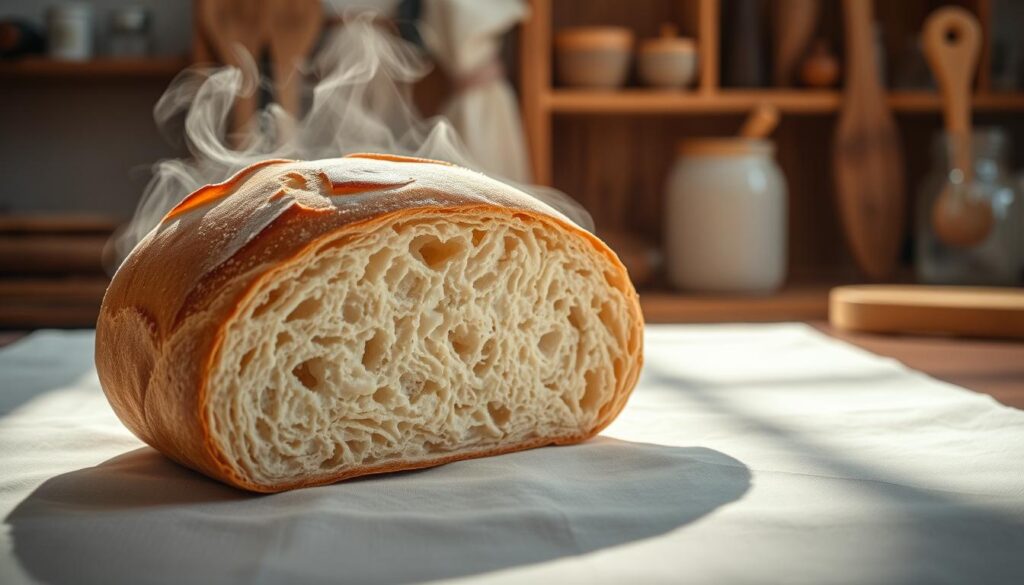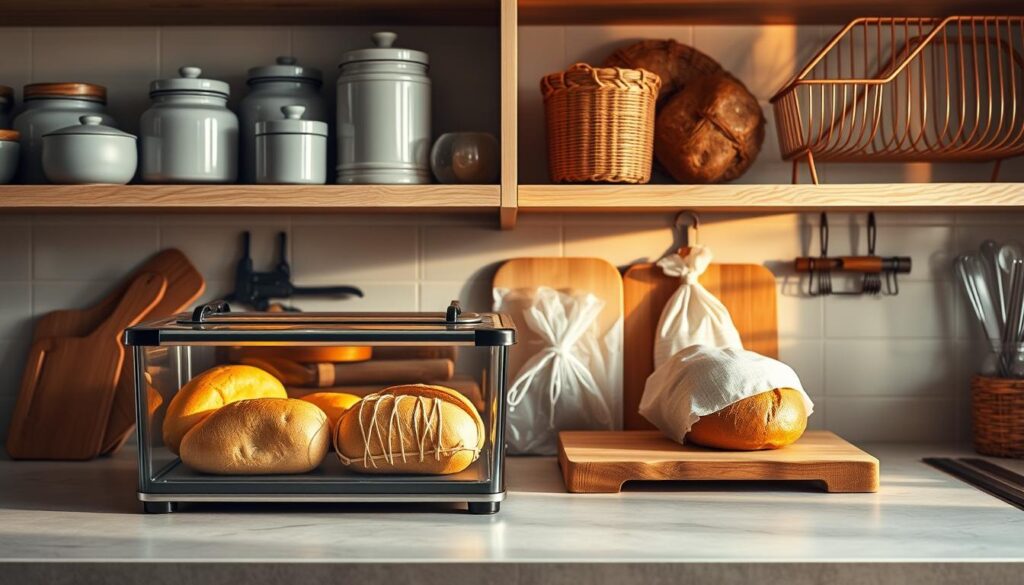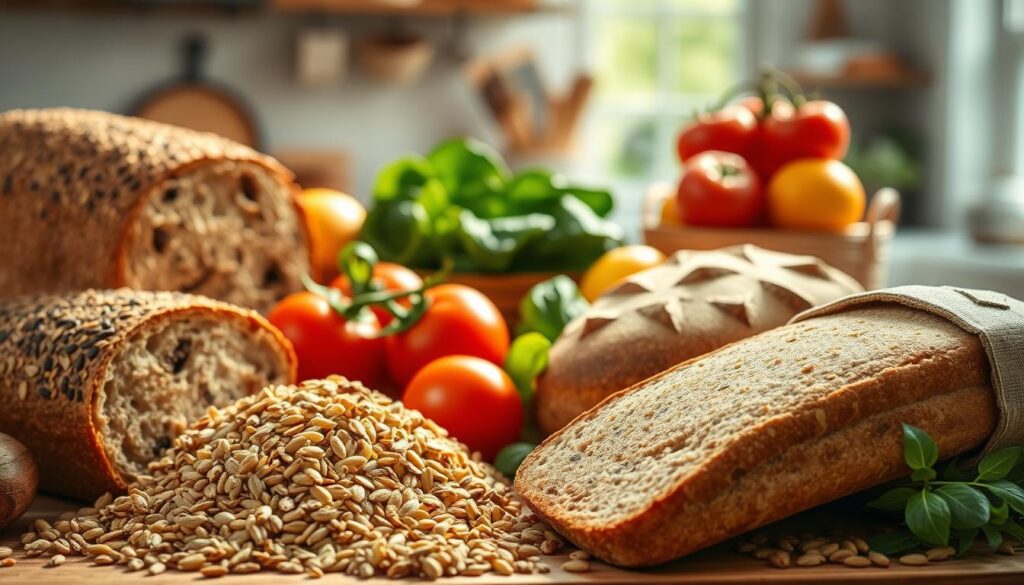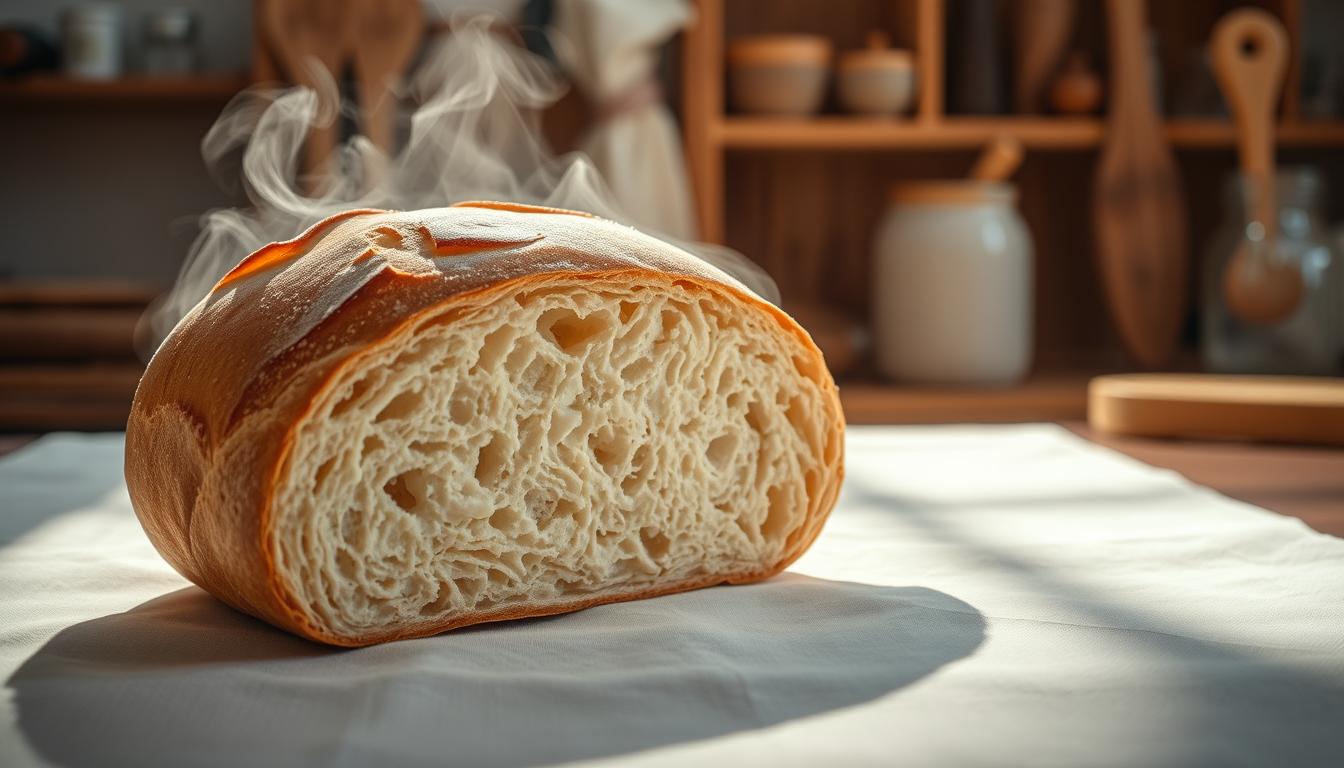Never Stale Bread, Imagine biting into a loaf of bread that’s always fresh. Thanks to new ways to store bread, we can now enjoy it for longer. This idea of bread that never gets stale is changing how we keep bread fresh. It makes it easy to have fresh bread whenever we want.

Having bread that never gets stale has many benefits. It saves us money by reducing waste. It also makes eating bread more enjoyable. Say goodbye to stale bread and hello to a fresher, tastier experience.
Key Takeaways Never Stale Bread
- Fresh bread can be stored for a longer period using the right techniques and ingredients.
- Bread that never goes stale is made possible by advancements in bread storage and preservation.
- Long-lasting bread reduces bread waste and saves us money.
- Fresh bread provides a more enjoyable eating experience.
- The concept of bread that never goes stale is revolutionizing the way we think about bread storage and preservation.
- With the right ingredients and storage techniques, we can enjoy fresh bread for a longer period.
The Problem with Traditional Bread Storage
Traditional ways of storing bread often lead to stale bread, causing a lot of food waste. In the United States, almost 40% of bread made ends up as waste. This problem comes from not storing bread well, making it stale too soon.
Storing bread right is key to keeping it fresh and cutting down on waste. Effective storage methods can prevent bread from getting stale. But, many people don’t know the best ways to store bread, leading to waste.
Some common mistakes in storing bread include:
- Storing bread in direct sunlight or near heat sources
- Keeping bread in a humid environment
- Failing to seal bread bags or containers properly
These errors can make bread stale fast, adding to the food waste problem. Knowing how to store bread properly can help reduce waste and keep bread fresh longer.
It’s important to cut down on food waste, especially with bread. By improving how we store bread and reducing stale bread, we can all help the environment. Better bread storage habits are a step towards sustainability.
The Science Behind Bread That Never Goes Stale
Bread science is a complex field that explores the chemistry of bread. It aims to keep bread fresh for longer. Natural preservatives are key in this process. They control mold and bacteria growth, which cause staleness.
Studies show that natural preservatives like vinegar and salt can extend bread’s shelf life. These preservatives create an environment that hinders microorganism growth. This prevents bread from becoming stale. Antioxidants and emulsifiers also help keep bread’s texture and flavor, making it taste fresher longer.
Understanding bread science is crucial for better preservation methods. By using natural preservatives and other ingredients, bread can stay fresh for days. This reduces food waste and makes eating bread more enjoyable. As we learn more about bread science, we’ll see even better ways to keep bread fresh for longer.
Revolutionary Ingredients for Longer-Lasting Bread
To make bread that stays fresh, companies are using new ingredients. These include natural preservatives to stop mold and bacteria. This keeps the bread fresh for longer.
Moisture-control elements are also key. They keep the bread’s moisture just right. This stops it from getting too dry or too wet, which can make it stale.
Enzyme technology is another big help. Enzymes break down starches, making the bread easier to digest. This also helps keep the bread fresh and tasty.
- Extended shelf life
- Improved texture and freshness
- Reduced waste and cost savings
- Enhanced nutritional value
By using natural preservatives, moisture-control elements, and enzyme technology, bread stays fresh longer. This cuts down on waste and makes the bread better.
Perfect Storage Techniques for Maximum Freshness
To keep bread fresh, it’s key to store it right. Store it in a cool, dry spot, away from sunlight and moisture. Use airtight containers or bread boxes to keep it fresh longer.
Freezing is another great way to keep bread fresh. It helps keep the texture and taste good, perfect for saving for later. Wrap it well in plastic wrap or foil to avoid freezer burn.
For a short time, you can store bread in the fridge. It slows down the bread getting stale, keeping it fresh for days. But, remember, the fridge can dry out bread. Store it in an airtight container or bag to prevent this.

- Storing bread at room temperature, away from direct sunlight and moisture
- Freezing bread to preserve its texture and flavor
- Using airtight containers or bread boxes to keep bread fresh
- Refrigerating bread for short-term storage
By using these storage tips, you can keep your bread fresh. This reduces waste and keeps your bread tasting great.
Making Your Own Bread That Never Goes Stale
Making homemade bread is fun and rewarding. You need the right tools and techniques to start. You’ll need a stand mixer, a bread machine, or a simple wooden spoon and bowl. These basics let you explore homemade bread, trying different recipes and tips to get the perfect loaf.
A good bread recipe is key. Here are some important ingredients and steps to keep in mind:
- Use high-quality flour, such as bread flour or all-purpose flour
- Choose the right type of yeast, such as active dry yeast or instant yeast
- Monitor the temperature and humidity levels during the proofing process
As you perfect your homemade bread, you might face common issues like a dense or soggy texture. Here are some troubleshooting tips:
- Check the expiration date of your yeast and flour
- Adjust the amount of liquid in the recipe
- Try a different type of flour or yeast
By following these tips and trying different recipes, you can make delicious homemade bread that stays fresh. Always use fresh ingredients and store your bread right to keep it fresh. With practice and patience, you’ll be baking like a pro in no time!
Health Benefits of Fresh-Keeping Ingredients
Using fresh-keeping ingredients in bread has many health benefits. These ingredients, like natural preservatives and moisture-control elements, keep bread fresh. They also add nutritional value. This makes bread healthier and more nutritious for consumers.
These ingredients help reduce the risk of chronic diseases like heart disease and diabetes. They are full of antioxidants and nutrients that protect cells and fight inflammation. They also support healthy digestion by providing prebiotic fiber and nutrients for good gut bacteria.

From a nutritional standpoint, fresh-keeping ingredients offer essential vitamins and minerals. For example:
- Vitamin E protects cells and supports healthy skin and hair.
- Fiber aids digestion, making you feel full and satisfied.
- Potassium helps maintain healthy blood pressure and heart health.
In summary, fresh-keeping ingredients in bread greatly improve its nutritional value. Choosing bread with these ingredients means you get a healthier option. It supports your overall health and well-being.
Environmental Impact of Reduced Bread Waste
Reducing bread waste greatly benefits the environment. It cuts down on waste sent to landfills and saves natural resources. Making, moving, and storing bread uses a lot of energy, water, and land. This leads to greenhouse gas emissions and climate change.
By cutting down on bread waste, we can lessen these problems. This supports sustainability in the food world.
The good news is that reducing bread waste offers many benefits. For instance, it saves water and energy in bread making. It also lowers emissions from moving and storing bread. Plus, it reduces landfill waste, which produces methane, a strong greenhouse gas.
Studies show that cutting bread waste by 10% can make a big difference. It’s like taking thousands of cars off the road. Using natural preservatives and moisture-control can help reduce waste. This supports a more sustainable food system.
Commercial Applications and Market Availability
More and more companies are looking into commercial applications for bread that stays fresh longer. Bakeries and grocery stores are now stocking up on this type of bread. Thanks to new tech and ingredients, we can enjoy fresh bread for longer.
Looking to buy bread that never goes stale? You have many places to check out. You can go to local bakeries, health food stores, or even shop online. It’s smart to compare prices to find the best deal and support eco-friendly food choices.
Brands like Arnold, Pepperidge Farm, and Dave’s Killer Bread are leading the way. They’ve made commercial applications a big part of their business. This means we can get fresh bread easily and help the planet at the same time.
When buying fresh-keeping bread, think about a few things:
- Ingredients used
- Shelf life
- Price
- Brand reputation
By looking at these points and comparing prices, you can choose wisely. This way, you get to enjoy fresh-keeping bread while also supporting the environment.
Conclusion: Embracing the Future of Fresh Bread
The era of fresh bread that never goes stale is here. This new way of making bread keeps it full of flavor and texture. It also helps cut down on food waste and supports sustainability in the food world.
Thanks to new preservation methods and ingredients, bakers can now make fresh bread that lasts longer. This change is good for the planet and opens up new chances for the bread industry. It lets them meet the needs of people who care about their health and the environment.
Looking ahead, we’ll see less bread waste and more fresh loaves for everyone. By choosing wisely and backing companies that care about the planet, we help make a better food system for the future.
FAQ
What is the science behind bread that never goes stale?
The secret to bread that never goes stale lies in science. It uses natural preservatives and controls moisture. Enzyme technology also plays a key role in keeping the bread fresh.
What are the key ingredients used to make bread that never goes stale?
To make bread that never goes stale, you need special ingredients. These include natural preservatives, like plant extracts. There are also moisture-control elements and enzyme technology to extend shelf life.
How can I store my bread to maximize freshness?
Keeping your bread fresh is all about how you store it. Use airtight containers and freeze for longer storage. Refrigeration helps prevent drying out and staleness.
Can I make my own bread that never goes stale?
Yes, you can make your own bread that stays fresh. With the right tools, recipe, and tips, you can enjoy fresh bread at home.
What are the health benefits of the fresh-keeping ingredients used in this bread?
The ingredients in this bread are good for you. Natural preservatives and moisture-control elements boost nutrition. They make the bread healthier without losing its taste or texture.
Where can I purchase bread that never goes stale?
You can find bread that never goes stale in many places. Look for it in grocery stores, specialty shops, and online. It’s available at good prices, making it easy to enjoy.
Table of Contents
Source
https://www.kingarthurbaking.com/blog/2022/02/15/the-science-of-keeping-bread-fresh
https://www.smithsonianmag.com/innovation/scientists-develop-mold-resistant-bread-180977890
https://www.seriouseats.com/how-to-store-bread-keep-it-fresh-longer
